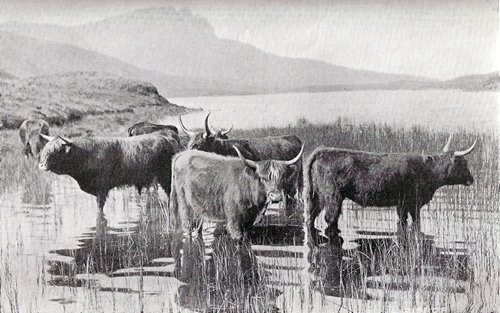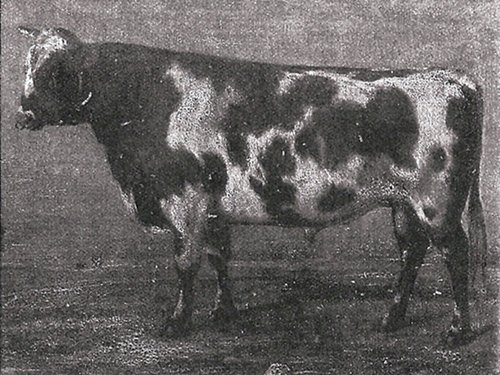|
Common origins of the Swedish Red and the Ayrshire breeds |
|
|
On this website there is a detailed description of the origins of the most important lines of Sires within the Swedish Red Breed - SRB. This description is pretty accurate, but it does not tell the whole truth. There are in fact several now extinguished lines of sires that have left their indelible mark in the genes of the Swedish Red Breed. One example of this is the bull 1 Balder from Stjärnsund in the 1870, unknown to most. His line lasted for only two generations, but his genes can be found in about 5 % of the SRB breed. I have recently received a copy of a most interesting piece of writing from 1901 from John Cochrane of the Scottish Ayrshire Association, titled "Famous Ayrshire Sires". Some of these bulls l have been able to identify in my own database, which covers 100 % of the first 30 volumes of "The Ayrshire Herdbook", thus further connecting the parentages within the Ayrshire breed. As the SRB cows of today carry mainly Ayrshire blood in their veins, this have enabled me to throw additional light also on the origins of the Swedish Red Breed. Even if there are still some blank spaces to be covered, we can now assess that an important part of the blood that runs in the veins of the SRB cattle of today, can be traced back to these particular bulls. This means that we are here talking about the true ancestors of the SRB breed. Background of the Ayrshire breed Before looking closer into these original sires from the beginnings of the Ayrshire breed in the 1820 and 1830, it is interesting to go even further back in time, to get an overview of the animals from which the Ayrshire breed would eventually evolve. As is the case of many other breeds, the earliest origins of the Ayrshire breed are shrouded in the mist of history. Through archaeological findings we know that there were cattle on the British Isles since the Stone Age. It would seem that these Stone Age cattle were somewhat smaller in size in Scotland than in England. Over a period of thousands of years, through commerce and migrations, genetic material from across the Channel has been introduced, but it is not possible to evaluate exactly how these movements may have affected the various breeds existing today in the different areas of Great Britain. Related to "The Wild Cattle"? Some of these British cattle roamed wild in the woods that at the time covered parts of northern England and the south of Scotland. Remnants of these wild or semi-wild cattle have been preserved within the walls of some vast parks until today. Small herds of the so called "Wild Cattle" or Chillingham cattle, still remains, supposedly some 80 animals. According to earlier authors, the tendency of the Ayrshire breed to turn whiter when inbred, might be an heritage from "The Wild Cattle". Modern genetically studies, however, contradict this assumption as it would seem that the Chillingham cattle has very little genetic relationship with any other European bovine breed.
|
|
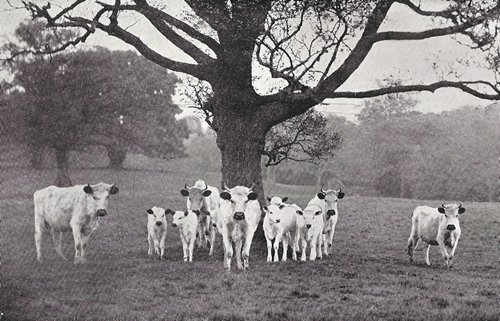
Herd of "Wild Cattle" in Hamilton Park where they have lived without any intromission of outside blood since the |
|
|
Middle Ages. There might be some distant relationship to the Ayrshire breed. Foto from end of 19th Century. |
|
|
Ravaging North men in 1263 According the to the legend, new bovine blood might have entered the county of Ayr in 1263. Supposedly an important amount of cattle would have swum ashore from a sinking fleet of ravaging "North men". On this topic Josef Ekelund wrote in 1901: "And their fleet sailed victorious along the northern and western coasts all the way to the islands of Arran and Bute outside the county of Ayr. But here the braves were halted by violent storms as well as by attacks of the population on the shores. Their large fleet was wrecked and it is said that an important number of cattle left the sinking ships and swimming reached the coast". These cattle might have been of Norwegian origin, but it is more likely that they were West Highland cattle, for "it is known that cattle were carried off as booty from the inhabitants of these parts".
|
|
|
Herd of West Higland cattle in a photo from the 19th Century. |
|
|
Strange as it may seem there is probably an not unimportant relationship with the Ayrshire breed. |
|
|
Spanish cattle from the "Invincible Armada" in 1588? The history would later have repeated itself when in 1588 large parts of the "Invincible Armada" of Philip II of Spain went under in a hurricane between Ireland and Scotland. Fifty-five of these ships are namely said to have taken aboard important numbers of Spanish cattle before sailing from the port of Lissabon on the 28th of May. On this subject Ekelund writes: "On the coast of Carrick close to Kirkoswald, where many ships were wrecked, numerous head of cattle would have saved their lives by swimming ashore, in the same manner as at Bute and Arran in the 13th Century. To what extent what happened in the years 1263 and 1588 really have had any lasting impact in the development of the Ayrshire cattle is rather uncertain - at least there are no lasting proofs of this being the case. But if we move forward another 100 years, to the year 1689, we arrive at a date that will be a starting point for a period of significant importations of cattle into the British Isles. Dutch cattle to Britain in 1690 As part of the European nations' wrestling for power and the religious feuds between Catholics and Protestants, Great Britain at this time came under Dutch rule. The Catholic king James II was replaced on the throne by his nephew and likewise son-in-law, the Dutch nobleman William of Orange, called William III in England and William II (or more informally "King Billy") in Scotland. William ruled Britain from 1689 until his death in 1702, first together with the daughter of Jacob II, Mary II and after her death in 1694, alone. During the 1690ies Dutch influence in Great Britain was vast and among other things, a great number of Dutch cattle, mainly of red or reddish colour, were imported. Most of these animals came to the regions around the river Tees, where they, mixed with the local animals, became the forebears of the so called Teeswater cattle, i.e. the animals from which the Shorthorn breed would eventually develop. During the 18th Century the Teeswater cattle successively reached the county of Ayr in southwestern Scotland - a development that continued well into the 19th Century. Very closely related to the Shorthorn breed. The Teeswater / Shorthorn breed is undoubtly the strain that has had the greatest impact on the Ayrshire breed - there may be as much as 50 % of common origins in the Ayrshire and Shorthorn breeds. Half of these common ancestors might well be the red Dutch cattle that arrived in England during the 1690ies. It is interesting to note that these red Dutch cattle, through mixing with mainly black animals from the North see provinces of Friesland and Gronningen during the 18th and 19th Centuries, also are genetic forebears of the modern Holstein cow. Among today's internationally recognized breeds, the Ayrshire group would therefore be more closely related to the Holstein group than to, for example, the Simmental- or Brown Swiss groups. But not only the Teeswater cattle have contributed to the genetics of the Ayrshire breed. It is documented that during the 18th Century, animals of the Alderney breed (an extinct breed from the British Channel Islands, closely related to the Jersey and Gurnesey breeds) were brought into England and there might well run some Alderney blood in the veins of the modern Ayrshire cow. As we will later see, it is not unlikely that there also is some West Highland blood to be found in the Ayrshire cow of today.....
|
|
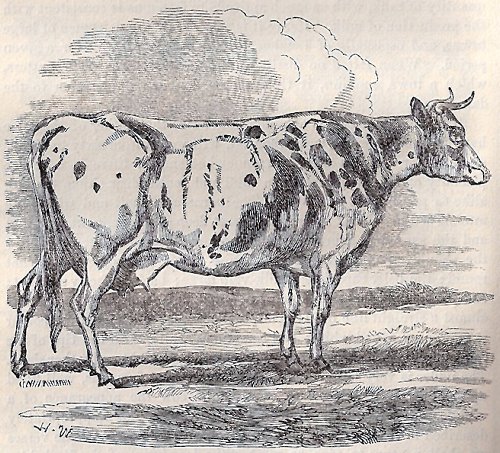 |
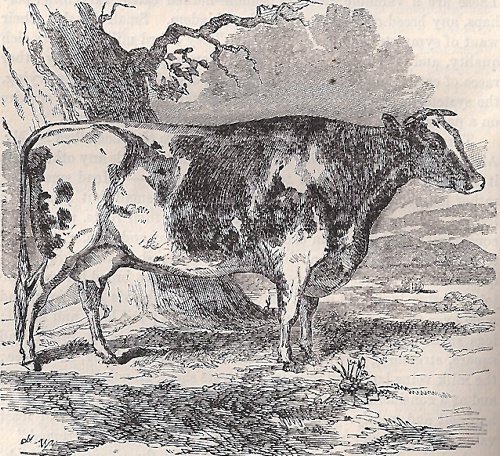 |
| Drawing of a Yorkshire cow from the earlier part of 19th Century. The Milking Shorthorn was often called "Yorkshire". No other breed has had a greater influence in the creation of the Ayrshire breed. | Drawing of an Ayrshire cow from the first part of the 19th Century. In the beginning the small rounded horns and the black colour was common. From the end of the 18th Century the red colour became more frecuent. |
|
The Ayrshire cow of the 18th Century was black Not much is known of the original breed in Ayr before 1690. According to some sources it was a small and unshapely cow, white in colour with black spots on the sides. Information from the middle of the 18th Century seems more certain, when black colour with white spots seems to have been dominating. From the end of the 18th Century and onwards, the red colour in varied nuances, from yellowish to dark red, seem to have been the most common coat, even though 5 % of the animals still were black as far as into the end of the 19th Century. There seem to be no doubt that the change in colour was caused by the influence of the Teeswater breed. Ayrshire is vast county in the southwestern part of Scotland that is divided into three parts - from the south these are Carrick, Kyle and in the far north Cunninghame. In Cunninghame, between Ayr and Glasgow, lies the Dunlop, from where the Ayrshire breed is said to have originated. Dunlop is since long known as a dairy area and is famous for its cheeses. In fact, before the Ayrshire breed became known by its actual name, it was known as Dunlop or Cunninghame cattle. The forebears of today's SRB cows We will now look more closely at some of the particular bulls that I mentioned in the beginning. These are Foundation Bulls that lived long before the first herd book was published. We can probably find them among the ancestors of the bull lines of today, but for the time being it is not possible to prove which bull is the forebear of which bull line. In some cases we can trace them through the line of the dams, till far back in the pedigrees of our modern bulls. In any case we can assume that an important part of the genes in the actual Ayrshire and SRB cows can be traced to these bulls. The Swinlees bull The oldest of these bulls would be the bull known as "Swinlees bull". He was probably born in the 1820 and was raised by a Mr Theophilus Paton at Swinlees Farm outside Dalry in northern Ayrshire. Especially interesting is the fact that he probably had quite bit of West Highland blood. Probably the exuberant horns and the sometimes dark faces of the Ayrshire cattle can be traced back to this particular bull. A grandson of his was called Geordie and got a second price at a Show in Girvan in 1840. As he was owned by Mr Ivie Campbell from Dalgig outside New Cumnock, one of the foremost breeders of the Ayrshire breed at the time, it is very likely that his blood was widely spread within the breed. Thus, Swinlees bull became a very important bull of the breed and we can actually find direct connections to him in some animals of today through the well-known bull White Prince AHB 63, to whom he is great great great great grandsire. Blackstone Old bull This bull also came from Dalry, from the herd of Mr Allan (apparently an older relative of Mr Andrew Allan of Munnoch farm, in Dalry, from where many important animals were imported to Sweden in the 1880, among others to Skarhult in the southern province of Scania). Blackstone Old bull was probably born in the beginning of 1830 and was undoubtly related to Swinlees bull - not only because of the geographical closeness, but he also had all the exterior signs: huge horns and a dark brown colour which became almost black on his head. Among his more important offspring we should mention Jocks the Laird (born in 1836 and a winner of shows three years running: from 1842 to 1844) and Tam of Dalgig, another long-lived bull with show ring records and huge horns, who unfortunately got a bit too temperamental in his old age. Holmbyre Sandy Another foundation bull from the neighbourhood of Dalry was Holmbyre Sandy. He was born at Swinlees farm around 1835 and worked until he was 12 years at the Holmbyre farm in Dalry. Possibly there is a genetically connection to Swinlees bull also in this case. His most important offspring was no doubt a dark brown bull who was sold to James Murdoch of Carntyne where he sired a son who was known as Carntyne (or Carantyne) and who ended up in one of the most important herds ever of the Ayrshire breed, namely at Mr James Howie, at Burnhouses outside Galston. Through the females at Burnhouses there are proven connections to - I dare say - all now living bovines with Ayrshire blood in their veins.
|
|
|
Geordie ( Logan's) Another famous foundation bull was the well-known Geordie; but he should not be mistaken for the aforementioned Geordie of Dalgig. This Geordie was bred by Mr James Walker of Stewarton (not far from Dunlop) and his owner was Mr Robert Logan of Stoneyholm, Kilbirnie, until he was finally sold to Mr Hunter on the island of Bute. His pedigree is unknown, but as can be seen from the picture, there is nothing in his appearance that would indicate any connection to Swinlees bull - his short horns and round body makes him very similar to the Shorthorn breed of that day. The fact that the name "Geordie" often is used when mentioning a person coming from the Tyneside area in the northwest of England - i.e. the most important region of the Shorthorn breed - at least does not contradict this supposition. Geordie was very sought after as a breeding bull in northern Ayrshire and its surroundings, where he as used by practically all the better-known breeders. As a further proof of his popularity, Geordie was sent all the way to Inverness in northern Scotland to participate in a show, where he won the 1st price. Because of his not uncommon name, it is not altogether easy to distinguish his sons from those of other Geordies, but one son who is identified beyond any doubt is the solid red "Mr Morton's Bull" (at Mr Morton's, Townhead of Drumley) who was born in 1843 and who sired many sons that were later sold. I have not been able to find any certain connections between Geordie and any animals of today, but it is most unlikely that he has not left a lasting genetic mark on the actual Ayrshire breed. |
The famous Ayrshire bull Logan's Geordie in a painting from 1840. |
|
There are certainly several important bulls worth mentioning from the beginnings of the Ayrshire breed until the Herd book was published in 1878, but they will have to wait till another time.... Per E. Falk
|
|
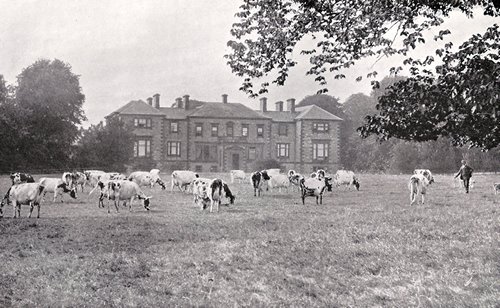 |
|
| A flock of the Ayrshire herd of Sir Mark Stewart in front of Southwick House. | |
| Many of these animals are probably daughters or granddaughters of Hover-A -Blink of Drumjoan. | |
| Photo from the end of the 19th Century. | |
